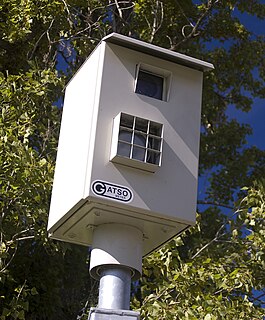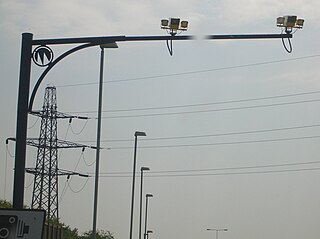Road speed limits are used in most countries to set the legal maximum or minimum speed at which road vehicles may travel on a given stretch of road. Speed limits are generally indicated on a traffic sign reflecting the maximum or minimum permitted expressed as kilometres per hour (km/h) and/or miles per hour (mph). Speed limits are commonly set by the legislative bodies of national or provincial governments and enforced by national or regional police and judicial authorities. Speed limits may also be variable, or in some places unlimited, such as on most of the Autobahn in Germany.

A traffic enforcement camera is a camera which may be mounted beside or over a road or installed in an enforcement vehicle to detect motoring offenses, including speeding, vehicles going through a red traffic light, vehicles going through a toll booth without paying, unauthorized use of a bus lane, or for recording vehicles inside a congestion charge area. It may be linked to an automated ticketing system.

The M1 motorway connects London to Leeds, where it joins the A1(M) near Aberford, to connect to Newcastle. It was the first inter-urban motorway to be completed in the UK; the first motorway in the country was the Preston By-pass, which later became part of the M6.
A highway patrol is either a police unit created primarily for the purpose of overseeing and enforcing traffic safety compliance on roads and highways, or a detail within an existing local or regional police agency that is primarily concerned with such duties. They are also referred to in many countries as traffic police, although in other countries this term is more commonly used to refer to foot officers on point duty who control traffic at junctions.

A radar speed gun is a device used to measure the speed of moving objects. It is used in law-enforcement to measure the speed of moving vehicles and is often used in professional spectator sport, for things such as the measurement of bowling speeds in cricket, speed of pitched baseball, athletes and tennis serves.
A safety camera partnership is a local multi-agency partnership between local government, police authorities, Her Majesty's Courts Service, Highways England/Welsh Government, and the National Health Service within the United Kingdom. Their aim is to enforce speed limits and red traffic lights by the use of cameras.

Northbourne Avenue is a major road in Canberra, Australia. It extends from City Hill in the south to the Federal Highway in the north. Its northern end is at the intersection with Antill and Mouat streets, but it is often considered to extend over the southern end of the Federal Highway to the intersection with the Barton Highway.

Speed limits in the United States are set by each state or territory. States have also allowed counties and municipalities to enact typically lower limits. Highway speed limits can range from an urban low of 20 mph (32 km/h) to a rural high of 85 mph (137 km/h). Speed limits are typically posted in increments of five miles per hour (8 km/h). Some states have lower limits for trucks and at night, and occasionally there are minimum speed limits.

Malaysian Federal Roads System, is the main national road network in Malaysia. All Federal Roads in Malaysia are under the purview of the Ministry of Works (MOW). According to the Ministerial Functions Act 1969, the MOW is responsible to plan, build and maintain all Federal Roads gazetted under the Federal Roads Act 1959. However, most of the Federal roads' projects were built and maintained by the Malaysian Public Works Department (JKR), which is also one of the implementing agencies under the MOW.

Vehicle activated sign (VAS) is a generic term for a type of road traffic sign which displays a message conditional upon the presence, or speed, of a road vehicle. The devices are deployed on roadsides like regular traffic signs in various countries. They are intended to help drivers by alerting them and drawing attention to danger or other undesirable situation.
Motorways of Pakistan are a network of multiple-lane, high-speed, controlled-access highways in Pakistan, which are owned, maintained, and operated federally by Pakistan's National Highway Authority. As of 20 February 2020, 1882 km of motorways are operational, while an additional 1854 km are under construction or planned. All motorways in Pakistan are pre-fixed with the letter 'M' followed by the unique numerical designation of the specific highway, e.g. "M-1".
Driving in the United Kingdom is governed by various legal powers and in some cases is subject to the passing of a driving test. The government produces a Highway Code that details the requirements for all road users, including drivers. Unlike most other countries in the world, the UK traffic drives on the left.

Active traffic management is a method of increasing peak capacity and smoothing traffic flows on busy major highways. Techniques include variable speed limits, hard-shoulder running and ramp-metering controlled by overhead variable message signs. It has been implemented in several countries, including Germany, the United Kingdom and the United States.

An advisory speed limit is a speed recommendation by a governing body, used when it may be non-obvious to the driver that the safe speed is below the legal speed. It is a posting which either approximates the Basic Speed Law or rule or is based on a maximum g-force exerted at a specific speed. Advisory speed limits are often set in areas with many pedestrians, such as in city centers and outside schools, and on difficult stretches of roads, such as on tight corners or through roadworks. While travelling above the advisory speed limit is not illegal per se, it may be negligence per se and liability for any collisions that occur as a result of traveling above the limit can be placed partially or entirely on the person exceeding the advisory speed limit.

Road signs in Thailand are standardized road signs similar to those used in other nations but with certain differences. Until the early 1980s, Thailand closely followed US, Australian, and Japanese practices in road sign design, with diamond-shaped warning signs and circular restrictive signs to regulate traffic. Signs usually use the FHWA Series fonts typeface also used in the United States.

Speed limit enforcement is the effort made by appropriately empowered authorities to improve driver compliance with speed limits. Methods used include roadside speed traps set up and operated by the police and automated roadside 'speed camera' systems, which may incorporate the use of an automatic number plate recognition system. Traditionally, police officers used stopwatches to measure the time taken for a vehicle to cover a known distance. More recently, radar guns and automated in-vehicle systems have come into use.

Road speed limits in the United Kingdom are used to define the maximum legal speed for vehicles using public roads in the UK. Speed limits are one of the measures available to attempt to control traffic speeds, reduce negative environmental effects of traffic, increase fuel use efficiency and satisfy local community wishes. The speed limit in each location is indicated on a nearby traffic sign or by the presence of street lighting. Signs show speed limits in miles per hour (mph) or the national speed limit (NSL) sign may be used.

Road speed limit enforcement in the United Kingdom is the action taken by appropriately empowered authorities to attempt to persuade road vehicle users to comply with the speed limits in force on the UK's roads. Methods used include those for detection and prosecution of contraventions such as roadside fixed speed cameras, average speed cameras, and police-operated LIDAR speed guns or older radar speed guns. Vehicle activated signs and Community Speed Watch schemes are used to encourage compliance. Some classes of vehicles are fitted with speed limiters and intelligent speed adaptation is being trialled in some places on a voluntary basis.

Statutory speed limit in Japan defaults to 100 km/h (62 mph) for divided national highways and 60 km/h (37 mph) for any other roads, unless otherwise posted. The highest speed limit in Japan is 120 km/h (75 mph) on some sections of Shin-Tōmei Expressway (E1A) and Tōhoku Expressway (E4). Urban two-way streets are usually zoned at 40 km/h (25 mph) or less.
HADECS or Highways Agency Digital Enforcement Camera System is a type of speed camera on roads in England, operated by Highways England.













